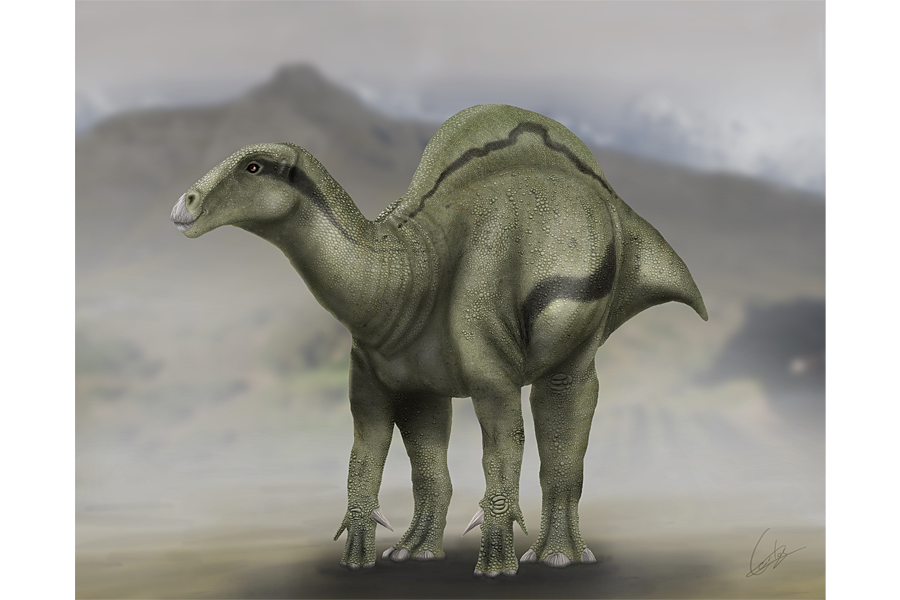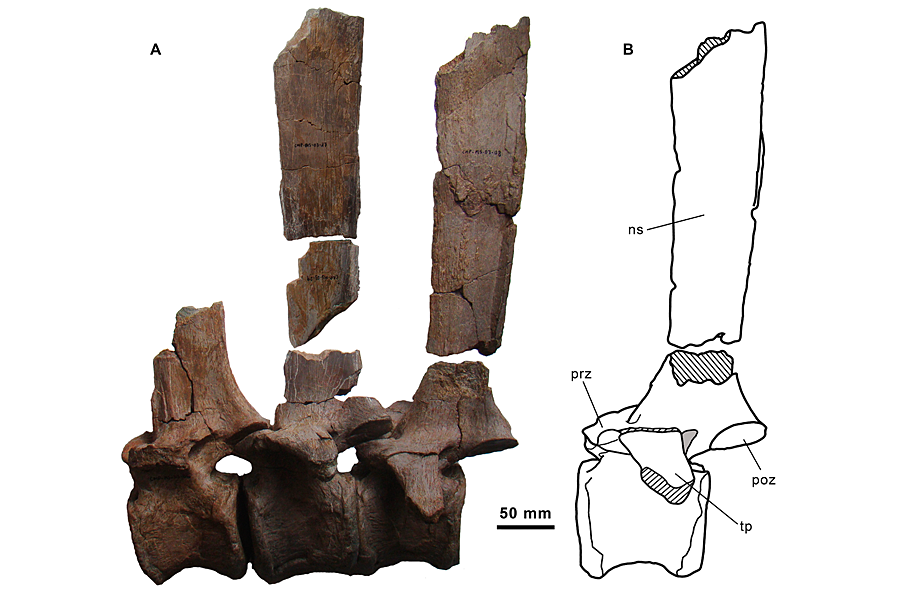Bizarre new dinosaur species sported a mysterious 'sail' on its back
Loading...
Scientists have found a new species of dinosaur with an intriguing appendage: a "sail" on its back.
In life, a ridge poked up from this plant-eating dinosaur's spine, forming the so-called sail.
Scientists aren't sure yet what purpose this unique feature could have served for the dinosaur. Could it have helped the animal regulate its body temperature? Was it extra fat storage? Or, did the dinosaur proudly use this sail for display?
Researchers describe the new dinosaur species, Morelladon beltrani, in a paper published Wednesday in the journal "PLOS ONE."
When it roamed the Earth some 125 million years ago, Morelladon stood just over eight-feet tall and stretched nearly 20-feet long. The animal would have been considered medium-sized among similar dinosaurs at the time.
Scientists discovered a partial skeleton Morelladon that they describe in the new paper. The fossils are mainly vertebrae and pelvic bones.
The vertebrae tipped researchers off to the animal's sail. They found elongated spinal bones that would have protruded vertically from the dinosaur's back, forming the feature.
"It's difficult to know what is the main function or purpose of this tall neural spine," study author Fernando Escaso tells The Christian Science Monitor in an interview.
Dr. Escaso suggests that the sail is related to thermoregulation, to keep the animals' bodies at a healthy temperature. But, he says, perhaps it is more like a camel's hump and stores extra fat for the animal for periods of low food supply.
"But we don't have direct evidence," he says. "We only have the bones. We don't have fat, we don't have tissue."
Paul Sereno, a paleontologist at the University of Chicago, who is not connected to the study, says in an interview with the Monitor that the new animal's sail is likely connected to display. Dr. Sereno, who has studied another sail-backed dinosaur, Spinosaurus, extensively, explains that the new species likely puffed up the sail somehow to seem bigger, more attractive to mates. The clues, he says, come from the other dinosaurs living in the same region at the same time.
Morelladon likely lived alongside some similar relatives in Europe. The researchers report that Morelladon was likely similar to Iguanodon bernissartensis and Mantellisaurus atherfieldensis, among others found throughout Europe.
Iguanodon was one of the most successful dinosaurs in its day, spreading across much of the globe. Even in our times the dinosaur achieved fame, as the main dinosaur character of Disney's 2000 film, "Dinosaur," was depicted as an Iguanodon.
Escaso says Morelladon was likely most similar to its movie-star cousin. Iguanodon was larger, stretching to an adult length of about 33 feet, walked both on all-fours and just on its hind-legs alternatively, and had a broad, stiff tail. Spikes are thought to have protruded as thumbs by the animal's three main fingers.
But Iguanodon didn't have a sail. And that's why Sereno says Morelladon's sail was likely for display purposes.
"They were thriving without it," Sereno says of Iguanodons and Morelladon's other relatives. Morelladon is "sitting right among a whole bunch of animals that don't have these high spines," he says. "They have a nice sturdy backbone, but they're not using their backbone" in this way.
As this new paper serves as the first description of Morelladon, Escaso expects further research to better evaluate the species' significance and sail. For now, he says, the important thing is that Morelladon indicates that there was remarkable diversity among these similar dinosaurs during the Early Cretaceous.
This new dinosaur species suggest that "there was an important rise of the diversity of this kind of dinosaur and it probably was the most common and dominated the environment during this time," Escaso says.
"We know that probably in the Jurassic, several million years older, the main ecosystem was inhabited by sauropods, long-necked dinosaurs," he says. "But during the Cretaceous, I think that this kind of dinosaur communities was the most important."
Filling in information about new animal species "is to complete the history of life on the Earth," Escaso says.
The find of Morelladon comes in the midst of a flurry of dinosaur-related discoveries. Recently, scientists stumbled upon a track of dinosaur footprints in Scotland, and just last week a new dinosaur species, deemed an ancient Triceratops cousin, was described from a discovery in China.
"We're naming dinosaurs at a pace faster than ever," Sereno says. "This is a dinosaur renaissance."









